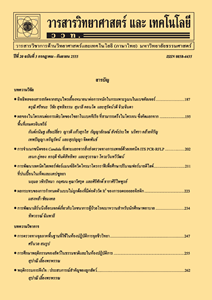การผลิตไบโอดีเซลจากน้ำมันพืชใช้แล้วด้วยโพแทสเซียมไฮดรอกไซด์ภายใต้คลื่นไมโครเวฟ
Main Article Content
Abstract
Biodiesel production cost is one of parameters defining the retail price of diesel currently being blended between biodiesel and diesel from petroleum. Therefore, excellent biodiesel production process can reduce the retail price. This research studies the factors that affect to biodiesel production from the used palm oil in a continuous flow system under microwave heating. The used palm oil was passed through the esterification process for reducing the amount of free fatty acid from 1.83 %wt. to 0.31 %wt. Then, this oil was passed through the transesterification process under the conditions such as the temperature of 50-60 ºC, alcohol to oil molar ratio in range of 6 : 1 to 12 : 1 and catalyst concentration of 1.0-2.5 %wt. From the studied results, the optimum conditions for transesterification were 60 ºC, 12 : 1 molar ratio of alcohol, and potassium hydroxide concentration of 2.5 %wt of catalyst, which resulted in 89.4 % FAMEs content. In addition, the biodiesel production from a tubular membrane reactor gave biodiesel with high purity than that from a regular tubular reactor under the same reaction conditions.
Keywords: biodiesel; microwave; used palm oil; potassium hydroxide; two-step reaction
Article Details
References
[2] กรมพัฒนาพลังงานทดแทนและการอนุรักษ์พลังงาน, แผนยุทธศาสตร์การใช้ไบโอดีเซล, แหล่งที่มา : https://https://www4.dede.go.th, 26 เมษายน 2560.
[3] Hoekman, S.K., Broch, A., Robbins, C., Ceniceros, E. and Natarajan, M., 2011, Review of biodiesel composition, properties, and specifications, Renew. Sustain. Ener. Rev. 16: 143-169.
[4] นิรันด์ สุมาลี, 2557, กว่าจะได้มาเป็นน้ำมันไบโอดีเซลสายพันธุ์ ม.อ. สงขลา, สำนักวิจัยและพัฒนา มหาวิทยาลัยสงขลานครินทร์, สงขลา.
[5] Encinar, J.M., 2011, Soybean oil transesterification by the use of a microwave flow system, Fuel 95: 386-393.
[6] ชาญณรงค์ อัศวเทศานุภาพ และศิริพรรณ กลั่นศิริ, 2557, การผลิตไบโอดีเซลด้วยกระบวนให้ความร้อนจากไมโครเวฟและการไหลต่อเนื่องและการทดสอบสมรรถนะของไบโอดีเซลในเครื่องยนต์ดีเซลสูบเดียว, ว.วิทยาศาสตร์และเทคโนโลยี, 22: 437-446
[7] Sherbiny, S.A.E., Refaat, A.A. and Sheltawy, S.T.E., 2010, Production of biodiesel using the microwave technique, J. Adv. Res. 1: 309-314.
[8] Teo, C.L. and Idris, A., 2014, Rapid alkali catalyzed transesterification of microalgae lipids to biodiesel using simultaneous cooling and microwave heating and its optimization, Bioresour. Technol. 174: 311-315.
[9] Koopmans, C., Iannelli, M., Kerep, P., Klink, M., Schmitz, S. and sinnwell, S., 2006, Microwave-assisted polymer chemistry: Heck-reaction, transesterification, Baeyer-villager oxidation, oxazoline polymerize-tion, acrylamide, Tetrahedron 62: 4709-4714.
[10] Leung, D.Y.C. and Guo Y., 2006, Trans-esterification of neat and used frying oil: optimization for biodiesel production, Fuel Proc. Technol. 87: 883-890.
[11] Zhang Y., Dube, M.A., McLean, D.D. and Kates M., 2003, Biodiesel production from waste cooking oil: 2. Economic assess-ment and sensitivity analysis, Bioresour. Technol. 90: 229-240.
[12] Eevera, T., Rajendran, K. and Saradha, S., 2009, Biodiesel production process optimization and characterization to assess the suitability of the product for varied environmental conditions, Renew Energy 34: 762-765.
[13] Freedman, B., Pryde, E.H. and Mounts, T.L., 1984, Variables affecting the yields of fatty esters from transesterified vegetable oils, J. Am. Oil Chem. Soc. 61: 1638-1643.
[14] Eevera, T., Rajendran, K. and Saradha S., 2009, Biodiesel production process optimization and characterization to assess the suitability of the product for varied environmental conditions, Renew Energy 34: 762-765.

